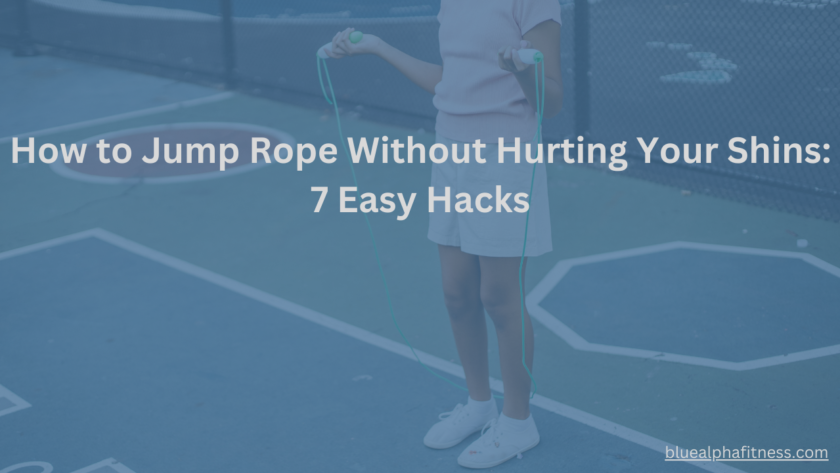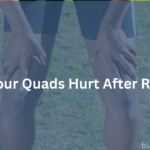Ever feel like your shins are ready to revolt every time you jump rope, leaving you wondering how to jump without hurting them?
That sharp ache can stop you in your tracks, making you question if the pain is even worth it. It’s more common than you think, and it’s frustrating when you just want to enjoy your workout.
Here’s how to jump rope without hurting your shins: Focus on a proper warm-up, choose softer surfaces, and fine-tune your jumping technique.
The best part? We’ll break down these simple but powerful hacks that’ll help you jump without the pain.
Don’t let shin pain steal your momentum. Dive into these tips and get back to pain-free jumping.
Ready to learn how? Let’s begin.
How to Jump Rope Without Hurting Your Shins: Simple Hacks for Pain-Free Jumps
Below is a list of simple yet effective hacks to help you jump rope without hurting your shins, so you can keep your workouts pain-free and effective.
Hack 1: Warm Up Properly Before Jumping Rope
Jumping straight into a workout without warming up is like trying to start a car on a cold winter morning—it just doesn’t work well.
When you skip the warm-up, your muscles aren’t ready for action, and your shins bear the brunt of it.
So, how do you warm up properly to save your shins?
- Start with 5-10 minutes of light cardio. Think brisk walking or a slow jog. This gets your blood pumping and your muscles warm.
- Next, dive into dynamic stretches that target your lower legs. Ankle circles and toe taps are your friends here. Therefore, rotate your ankles in both directions to loosen them up.
- For toe taps, sit on a bench or chair, lift your toes while keeping your heels on the ground, then tap your toes back down.
These stretches might seem simple, but they work wonders. They get the blood flowing to your shins and calves, prepping them for the workout ahead.
Think of it as waking up your muscles gently instead of shocking them awake.
When your muscles are warm and flexible, they’re less likely to get injured. So, invest those extra minutes in a proper warm-up—it’s worth it.
Hack 2: Choose the Right Surface for Jumping Rope
Imagine jumping rope on concrete. Ouch, right?
The hard, unforgiving surface sends shockwaves up your legs, and your shins take a beating.
Now, picture jumping on a soft, springy surface. Much better.
The surface you choose makes a huge difference.
- Opt for rubber mats, grass, or wooden floors. These surfaces absorb more impact, reducing the stress on your shins.
- Avoid concrete and asphalt. They’re hard on your body and can quickly lead to shin pain.
- If you don’t have access to softer surfaces, consider investing in a good-quality rubber mat. It’s a small investment for a big payoff in comfort and injury prevention.
When you jump on a forgiving surface, the impact is less jarring.
It’s like having a cushion between you and the ground. This reduces the micro-trauma to your shin bones and surrounding muscles.
Over time, this can make a big difference in how your shins feel during and after your workout.
Hack 3: Choose Proper Footwear for Your Jump Rope Sessions
Ever tried jumping rope in worn-out sneakers? It’s a recipe for disaster.
Your shoes are your first line of defense against impact, and wearing the right pair is crucial.
So, what should you look for in a good pair of jumping shoes?
- First, go for cushioning. Your shoes should have good padding to absorb shock.
- Look for shoes with solid arch support to keep your feet stable.
- Don’t forget to check the soles— they should be durable yet flexible.
And remember, shoes wear out. Replace them regularly to ensure they provide the support you need.
Good shoes act like shock absorbers. They reduce the force that travels up your legs each time you land.
Without this support, your shins end up taking on more stress, which can lead to pain and injury. Proper footwear keeps your feet and legs aligned, making each jump smoother and less jarring.
It’s a small change that can make a world of difference.
Hack 4: Use Correct Jump Rope Technique
You might think jumping rope is just about, well, jumping. But technique matters—a lot. Poor form can wreak havoc on your shins.
So, what’s the right way to jump rope?
- Keep your jumps low. Aim to lift your feet just 1-2 inches off the ground. This minimizes the impact when you land.
- Touch down gently on the balls of your feet, avoiding your heels. This allows your calves to absorb more shock.
- Keep a slight bend in your knees to cushion your landing further.
Imagine you’re trying to sneak up on someone—silent, controlled movements. This helps minimize strain on your shins.
Proper technique isn’t just about avoiding pain; it’s also about efficiency. You’ll be able to jump longer and with more control, making your workouts more effective.
Hack 5: Progress Slowly to Protect Your Shins and Prevent Injury
It’s tempting to go all out when you’re motivated. But jumping into intense workouts too quickly can lead to trouble.
Your body needs time to adapt to new stresses, and this is especially true for high-impact activities like jumping rope.
So, start with short sessions.
Even just 1-2 minutes is fine if you’re new to it. Gradually increase your duration as your body adapts.
Don’t forget to incorporate rest days. Your muscles require time to heal and build strength.
Think of it like building a house. You need a solid foundation before adding more layers.
Pushing too hard too soon can cause injuries, setting you back instead of moving you forward.
Gradual progression allows your shins and the rest of your body to adjust, reducing the risk of pain and injury.
Hack 6: Add Shin-Strengthening Exercises for Better Support
Your shins don’t work alone. They’re part of a team of muscles that need to be strong to support your activities.
Strengthening exercises can bolster this support system, making your shins more resilient.
Therefore, you should incorporate toe raises, calf raises, and shin stretches into your routine.
- Toe raises are simple: Sit on a chair or bench with your feet flat on the floor. Keeping your heels on the ground, lift your toes as high as possible, then slowly lower them back down. For added resistance, you can place a dumbbell or barbell on your thighs near your knees, but this is optional.
- For calf raises, stand with your feet shoulder-width apart, rise onto your toes, then slowly lower back down. Perform these exercises 2-3 times a week.
These exercises might seem small, but they pack a punch. They build strength in the muscles around your shins, providing better support and stability.
Stronger muscles mean less strain on your shins, reducing the risk of pain. Think of these exercises as armor for your shins, protecting them from the impact of jumping rope.
Hack 7: Listen to Your Body—It Knows When Something’s Wrong
Your body has a way of telling you when something’s wrong. It’s up to you to listen.
If you feel discomfort or pain in your shins, don’t ignore it.
It’s better to address small issues before they become big problems.
Pay attention to any signs of discomfort. If you start feeling pain, take immediate action.
- Rest is your first line of defense.
- Ice the area to reduce inflammation.
- Use compression and elevate your legs to promote healing.
- If the pain persists, consider seeing a healthcare professional.
Ignoring pain can lead to more serious injuries.
It’s like a warning light on your car’s dashboard—you can’t just cover it with tape and hope the problem goes away.
Listening to your body and addressing issues early can prevent long-term damage, keeping you in the game and pain-free.
By incorporating these seven hacks into your routine, you can enjoy the benefits of jumping rope without the shin pain.
Keep in mind, a small amount of prevention can make a big difference.
FAQs: How to Jump Rope Without Hurting Your Shins (Your Top Questions Answered)
Now, let’s address some common questions to help you jump rope without hurting your shins and keep those painful setbacks at bay.
1. What does it mean when you jump your shins hurt?
If your shins hurt when you jump, it means you might be experiencing shin splints or overuse injuries. This can happen due to improper technique, inadequate footwear, or jumping on hard surfaces. It’s important to address these issues to prevent further pain and injury.
2. What is the ideal leg position when jumping rope?
The ideal leg position when jumping rope is to keep your knees slightly bent. This helps absorb the impact and reduce strain on your shins and joints. Landing softly on the balls of your feet also aids in minimizing stress.
3. How long to jump rope for beginners?
Beginners should jump rope for about 1-2 minutes per session. Slowly extend the duration as your fitness progresses. This helps your body adapt to the new exercise and reduces the risk of injury.
4. What happens if I jump rope every day?
If you jump rope every day, you can improve cardiovascular fitness, coordination, and muscle tone. However, it’s important to listen to your body and incorporate rest days to prevent overuse injuries. Consistency, combined with proper technique, is key to seeing benefits without harm.
5. How long does it take to see results from jumping rope?
It takes about 2-4 weeks to see noticeable results from jumping rope. This includes improved endurance, weight loss, and muscle toning. Consistency and a balanced diet play crucial roles in achieving these results.
6. Can you get in shape by just jumping rope?
Yes, you can get in shape by just jumping rope. It’s an effective full-body workout that burns calories, builds strength, and enhances cardiovascular health. Combining it with a balanced diet and other forms of exercise can optimize results.
7. How many times should I jump rope to lose belly fat?
You should jump rope for at least 20-30 minutes, 3-5 times a week, to help lose belly fat. This consistent aerobic exercise, combined with a healthy diet, promotes fat loss and overall fitness. Always start with shorter sessions if you’re a beginner and gradually increase the duration.
8. How do you know if a jump rope is long enough?
You know a jump rope is long enough if you can stand on the middle of the rope and the handles reach your armpits. This length allows for proper rotation and jumping without tripping. Adjusting the rope to your height is crucial for an effective workout.
9. Are there any side effects of skipping?
There are side effects of skipping, including potential joint strain, shin splints, and foot injuries if not done properly. Proper footwear, technique, and surface choice can minimize these risks. Listening to your body and not overdoing it are also important to prevent injuries.
10. Does jumping rope slim your waist?
Yes, jumping rope can slim your waist. It’s an effective calorie-burning exercise that helps reduce overall body fat, including around the waist. Consistent practice combined with a healthy diet enhances these slimming effects.
Wrapping Up: How to Jump Rope Without Hurting Your Shins
Feeling frustrated with shin pain is completely normal. You’re pushing your limits, giving it your all, and yet, those pesky shins just won’t cooperate.
It’s like your body’s putting up roadblocks on your path to fitness glory.
But here’s the thing—you’ve already taken the first step by seeking out solutions. That shows your dedication and determination.
Remember, each hack we’ve discussed is a tool to keep you jumping pain-free and enjoying every session.
From proper warm-ups and smart surface choices to the right footwear and perfecting your technique, every tip is designed to support you.
You’re not just jumping rope; you’re investing in your health, your strength, and your endurance.
Think about how incredible it’ll feel when you can jump rope with ease, no longer worrying about shin pain.
Picture the rhythm of your jumps, the sweat on your brow, and the satisfaction of a workout well done.
You’ve got the knowledge now—use it. Embrace these hacks, and make them a part of your routine.
Your shins will thank you, and your fitness journey will be all the more rewarding for it.
So, lace up those shoes, grab your rope, and get ready to conquer your workouts.
You’ve got this. Here’s to pain-free jumping and unstoppable progress!



